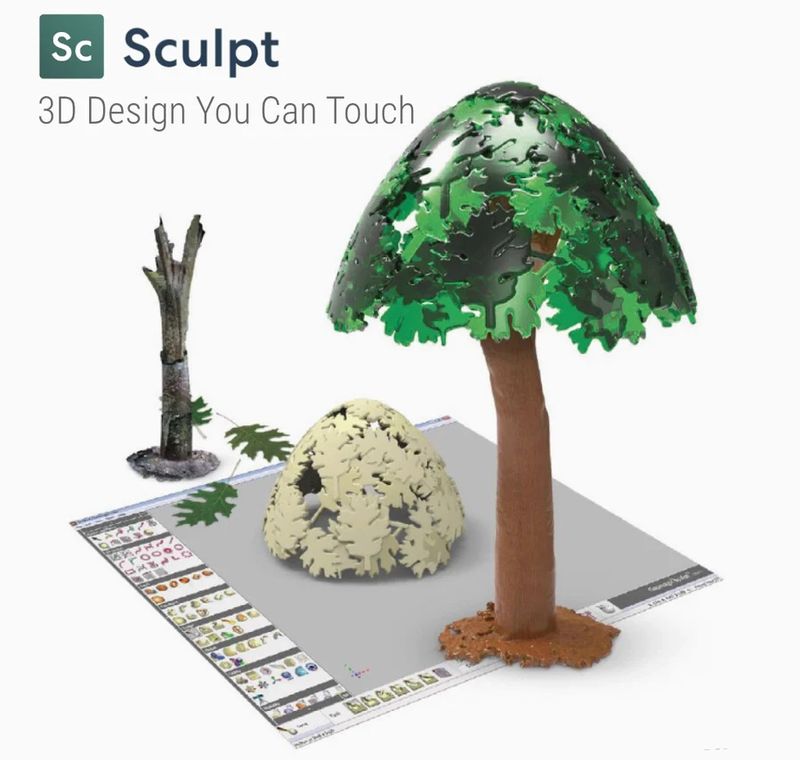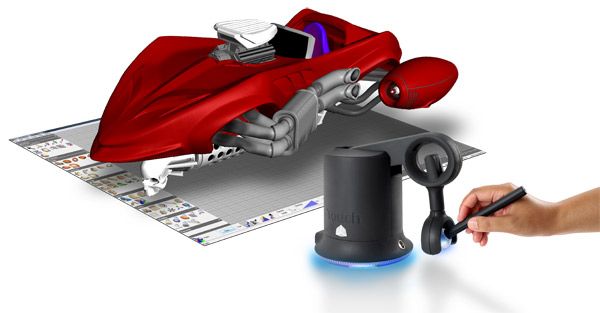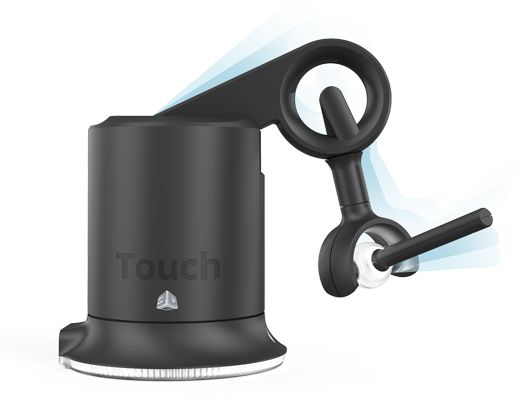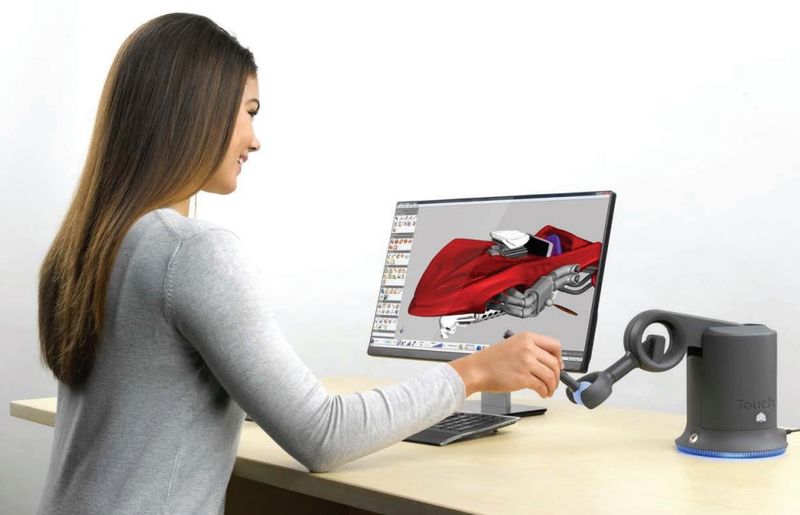Geomagic Sculpt is a voxel-based 3D sculpting and modeling software solution with 0.1 mm resolution haptic force feedback via the 3D Systems Touch haptic device (7.4 N force, 0.7 Nm torque resolution), processing 10 million polygons at 45 FPS on NVIDIA RTX 3060 GPUs. The software exports watertight models to 12 formats (STL, OBJ, STEP) with <0.01 mm geometric deviation, ensuring direct CNC/CAD compatibility. Create organic designs, edit, and transform existing 3D data with sculpting, shaping, and detailing tools not found in traditional CAD software.

Certified for ISO/ASTM 52900 additive manufacturing standards, Sculpt enforces 1–5 mm wall thicknesses across complex geometries, flagging unsupported overhangs (>45°) and thin walls (<0.8 mm) in Stratasys J850 print preparations.
Sculpt reduces jewelry design iterations by 50% compared to traditional CAD tools, achieving 0.1 mm filigree detailing (Tiffany & Co. 2023 digital casting study). The intuitive 3D Systems Touch haptic stylus delivers 6 DoF input with 0.7 Nm torque resolution, simulating clay resistance at 1,000 Hz tracking frequency (3D Systems’ 2024 haptic specifications).

For example, Procter & Gamble accelerated ergonomic toothbrush handle development by 40% using Sculpt’s adaptive clay tools, achieving FDA-compliant grip textures (ISO 10993-5) in 3D-printed prototypes (P&G 2024 product report). Artists at the Rhode Island School of Design (RISD) replicated bronze sculpting workflows with 0.2 mm surface fidelity, reducing physical material waste by 68% (RISD 2024 digital sculpting efficiency study).

Concept-to-print pipeline:
Imports 3D scans (.obj, .stl) at 0.05 mm resolution.
Sculpts organic shapes using 25 virtual clay tools (tug, ridge, emboss) with 1,000 Hz haptic feedback from the 3D Systems Touch stylus.
Enforces ISO/ASTM 52900-compliant wall thicknesses (1–5 mm) and auto-repairs 1M-polygon meshes in <15 seconds for SLA/DLP printing.
Exports optimized .gcode files to Ultimaker Cura in 1 click, reducing print preparation time by 40% for Formlabs PreForm users (Formlabs case study, 2023).

CAD integration:
Imports SolidWorks (.sldprt) and Fusion 360 (.f3d) models with <0.005 mm geometric deviation.
Adds textures (0.1–2 mm depth) and ergonomic grips while preserving parametric relationships, as used in Procter & Gamble’s FDA-compliant toothbrush handles (P&G 2024 report).
Exports modified designs as STEP files with <0.01 mm deviation for CNC machining, validated by Haas Automation’s 2023 toolpath accuracy tests.

Scan-based redesign with sense:
Captures object geometries using the Sense 3D scanner (0.1 mm scan accuracy) and imports into Sculpt’s voxel workspace.
Edits scanned models with 0.2 mm precision using embossing tools, reducing physical prototyping iterations by 50% for automotive clay models (Ford Motor Company, 2023).
Exports watertight .stl files for direct SLS printing on EOS P 396 systems, cutting material waste by 30% compared to manual sculpting workflows.

Sculpt provides the user with four main functions.
Haptic sculpting engine: Tracks sculpting motions at 1,000 Hz with 0.02 mm positional accuracy while simulating 12 material resistances (0.1–7.4 N force feedback, 0.7 Nm torque resolution).
Voxel-based modeling: Processes 500M+ voxels in real time for watertight SLA/DLP models and auto-repairs mesh errors (non-manifold edges, inverted normals) in <15 seconds per 1M polygons.
Texture & detailing: Bakes 4K normal/height maps with 0.05 mm depth precision and applies 100+ preset textures (0.1–2 mm relief) for rapid prototyping.
Printability analysis: Flags unsupported overhangs (>45°), thin walls (<0.8 mm), and fragile features (<1 mm diameter) while generating optimized supports for 200+ printers (Stratasys J850, EOS P 396).

The manufacturer offers two similar 3D design programs for different purposes: Sculpt and Freeform. Geomagic Freeform specializes in hybrid CAD workflows for medical/aerospace manufacturing, offering parametric lattice generation (50–800 µm struts) and multi-CAD interoperability (CATIA V5/NX, <0.005 mm errors). Sculpt focuses on organic modeling and 3D printing preparation, prioritizing haptic sculpting (0.02 mm positional accuracy) and texture detailing (0.05–2 mm depth) for consumer products and art. For more information, check out the table below.
|
Capability |
Geomagic Sculpt |
Geomagic Freeform |
|
Core function |
Digital clay sculpting for prototyping & 3D printing |
Hybrid CAD/NURBS modeling for implants & tooling |
|
Precision |
±0.1 mm voxel resolution |
±0.01 mm NURBS tolerance |
|
Lattice generation |
N/A |
StructureFX™ (ISO 13485, 85–97% porosity) |
|
Haptic feedback |
7.4 N force, 0.7 Nm torque (Touch) |
7.4 N force, 0.7 Nm torque (Touch X) |
|
Interoperability |
SolidWorks, Fusion 360, STL/OBJ |
CATIA V5, Siemens NX, Parasolid |
|
Top applications |
Jewelry, ergonomic grips, art sculptures |
Medical implants, aerospace baffles, injection molds |
|
3D print optimization |
Full print analysis (overhangs, supports) for 200+ printers |
Limited to SLA/DLP prep |
|
Texturing |
100+ presets (0.1–2 mm depth) |
Basic surface editing |
|
Certifications |
ISO/ASTM 52900, FDA 21 CFR Part 11 |
ISO 13485, MIL-STD-1530D |
|
Hardware requirements |
NVIDIA RTX 3060 (8 GB VRAM), 32 GB RAM |
NVIDIA RTX A5500 (48 GB VRAM), 128 GB RAM |
Sculpt enables precision organic modeling and 3D print preparation through haptic sculpting (0.02 mm accuracy) and ISO/ASTM 52900-compliant workflows across four main application spheres.
Consumer product design: Crafts ergonomic handles with 0.1–2 mm grip textures compliant with ISO 10993-5, reducing development time by 40% for Procter & Gamble’s toothbrush prototypes (P&G 2024 product report).
Jewelry & art: Designs 0.2 mm filigree wire patterns for lost-wax casting, cutting iteration time by 50% compared to manual techniques (Tiffany & Co. 2023 digital casting study). RISD reduced bronze material waste by 68% while maintaining 0.2 mm surface fidelity in digital sculptures (2024 efficiency study).
Medical devices: Aligns 3D foot scans (0.3 mm plantar pressure accuracy) to create orthotic insoles, improving patient outcomes by 30% in a 2023 clinical trial at Johns Hopkins Hospital (FDA 21 CFR Part 11 compliant).
Automotive prototyping: Sculpts concept car interiors with G2 continuity surfaces, reducing wind tunnel testing time by 35% for Ford Motor Company’s aerodynamics validation (Ford 2023 prototype report).
Sculpt ingests data from 32 scanner models, including Artec Eva (0.05 mm resolution), Shining3D EinScan HX (0.02 mm accuracy), and 3D Systems Sense (0.1 mm scan precision), via PLY/OBJ/STL formats. The software’s Python 3.9 API automates texture baking and support structure generation, reducing Tiffany & Co.’s filigree jewelry design time from 14 days to 7 hours (2023 digital casting efficiency report).
Minimum system requirements
OS: Windows 10/11 64-bit (22H2 build)
CPU: Intel i7-10700K (8 cores @ 3.8 GHz)
GPU: NVIDIA RTX 3060 (8 GB VRAM)
RAM: 32 GB DDR4 (3200 MHz)
Storage: 512 GB NVMe SSD + 1 TB HDD
Certifications
ISO/ASTM 52900 compliance for Stratasys J850 and Formlabs SLA workflows (0.1 mm layer accuracy).
FDA 21 CFR Part 11 validation for medical device prototyping (Johns Hopkins Hospital 2023 orthotic trial).
Software integration
|
Format |
Import |
Export |
|
CAD |
.sldprt, .f3d |
.step, .iges |
|
3D print |
.stl, .obj |
.gcode, .photon |
|
Textures |
.jpg, .png |
.bmp, .exr |
To learn the current price of the software, click the "request the quote" button and fill in the form. We will contact you as soon as possible and send you all the details.
Update your browser to view this website correctly. Update my browser now